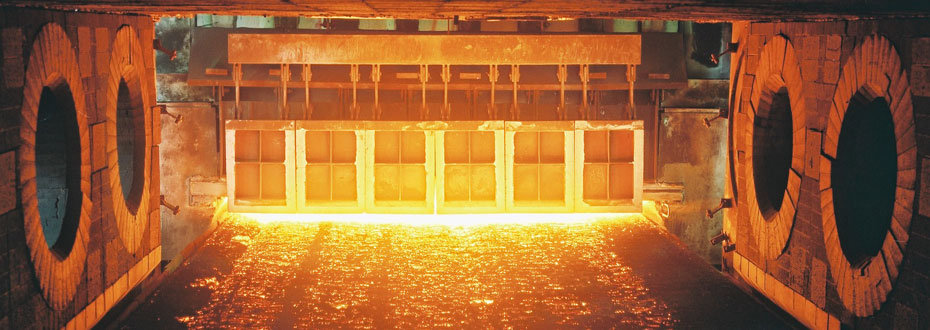Iron Extraction Process
In the blast furnace process, the first step on the way towards heavy plate, pig iron is produced from iron ore. The composition of the ore and additions is accurately adjusted to the final products of AG der Dillinger Hüttenwerke and Saarstahl AG.
Burdening
Exact quantities of burdening materials such as sinter, pellets, lump ore, alloys, and coke are transported alternately via a belt conveyor to the blast furnace head. The materials are then charged in layers via sluice vessels into the furnace by means of a rotary chute.
Cowper
This supplies the blast furnace with a current of hot air ("blast"), which initiates the chemical reaction. The refractory checker bricks in the Cowper are heated by the top gas produced in the blast furnace. The blast, which reaches temperatures of over 1300 °C (regenerator), then flows through these hot bricks. The energy for the blast heating is thus drawn off from the blast furnace process - an utmost environmentally-sound method.
Blast furnace
The blast furnace works according to the counterflow principle: the stock column, made up of ore, coke and additions, slides down towards its conversion, while the top gases rise and heat the stock column. At the bottom of the furnace the iron ore is chemically reduced. The blast reacts with the coke; carbon dioxide and carbon monoxide are formed at temperatures of up to 2000 °C.
The carbon monoxide removes the oxygen from the iron ore resulting in pig iron production. Slag is formed from the other ore components and the additions.
Casting bay
The hot metal is filled into torpedo cars via the blast furnace tap hole, launder lined with refractory material, and transported to the steel plants of AG der Dillinger Hüttenwerke and Saarstahl AG. The silicon content of between 0.3 % and 0.5 % is already adjusted to steel plant and rolling mill requirements. A modern dust extractor prevents dust from escaping during tapping. The slag obtained in the blast furnace process which floats on top of the hot metal in the launder, due to its low specific gravity, is separated from the metal and poured into slag dumps where it solidifies or is immediately granulated with high-pressure water. The solidified slag is used as road building material, whereas the granulated material is supplied to the cement industry.

